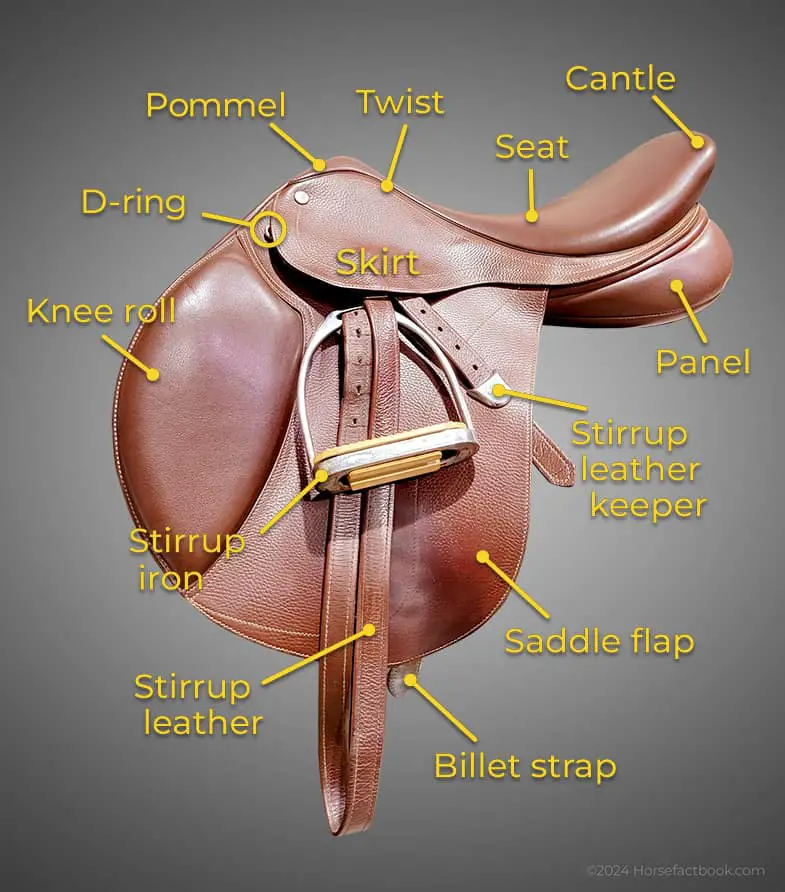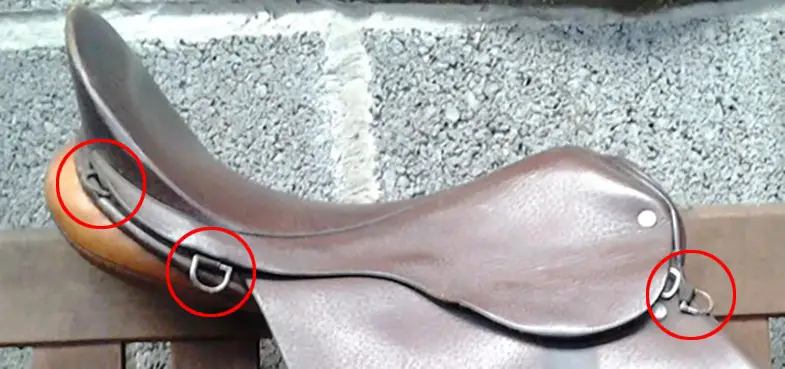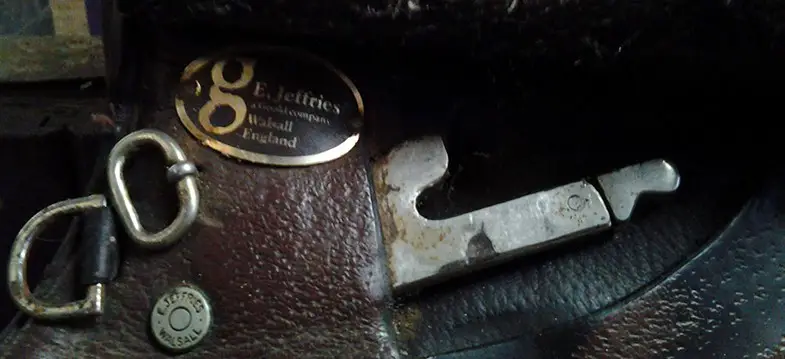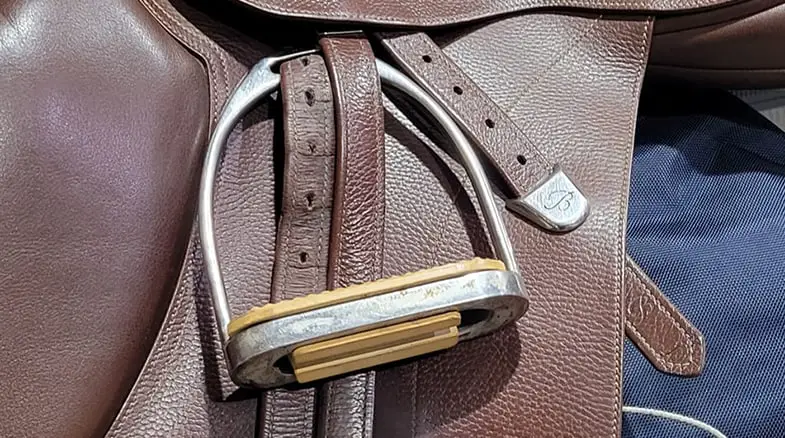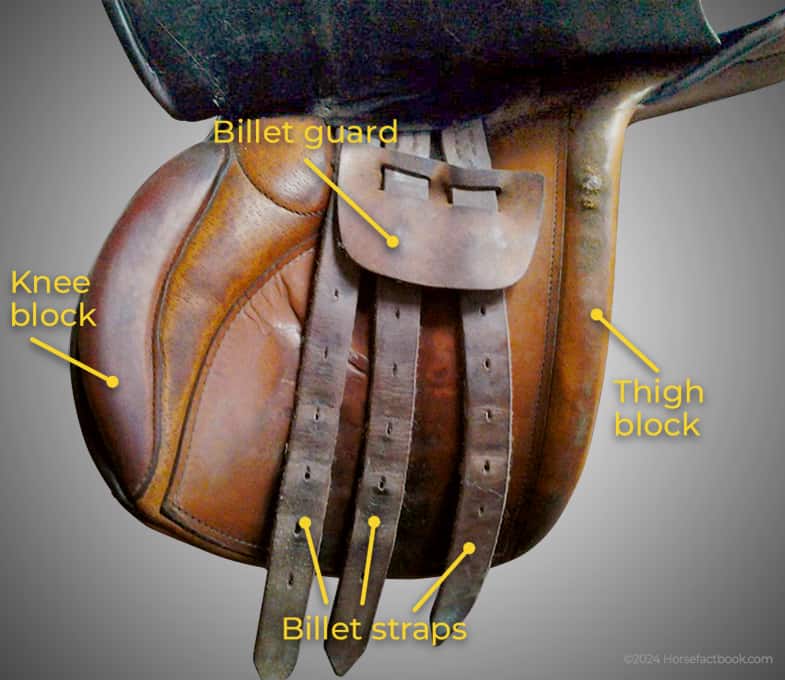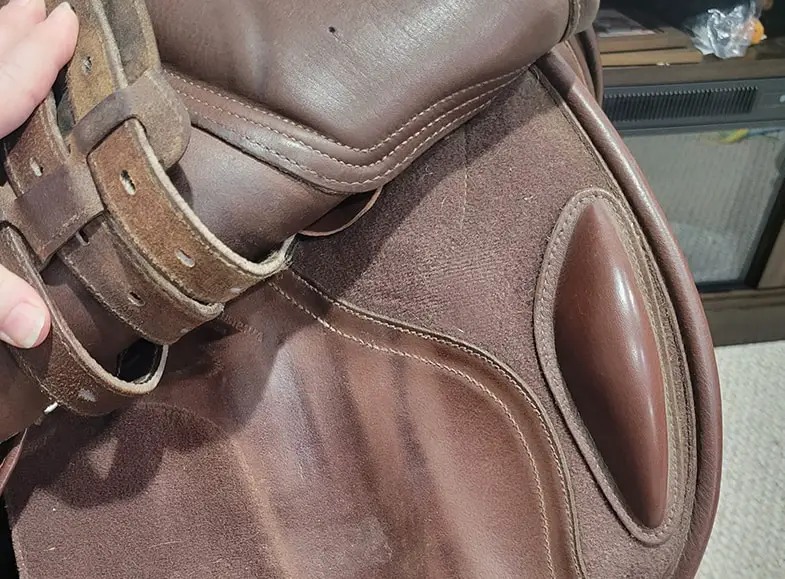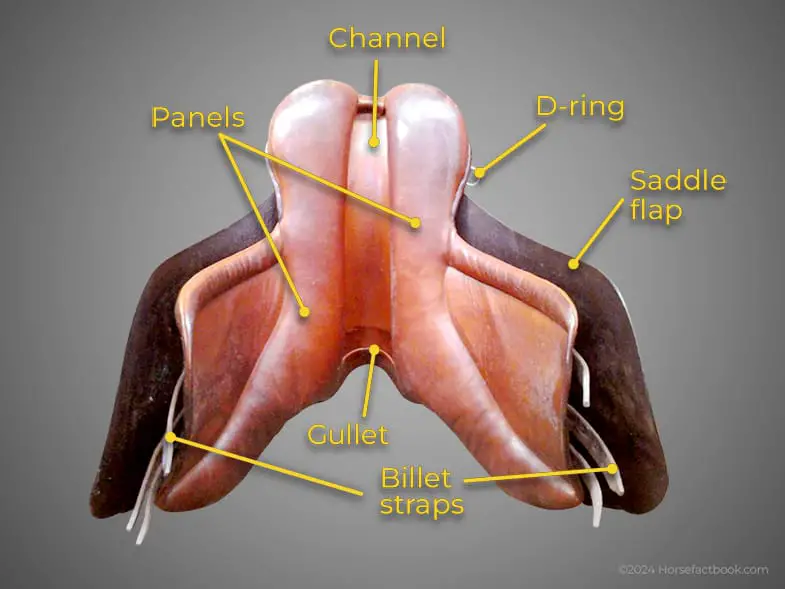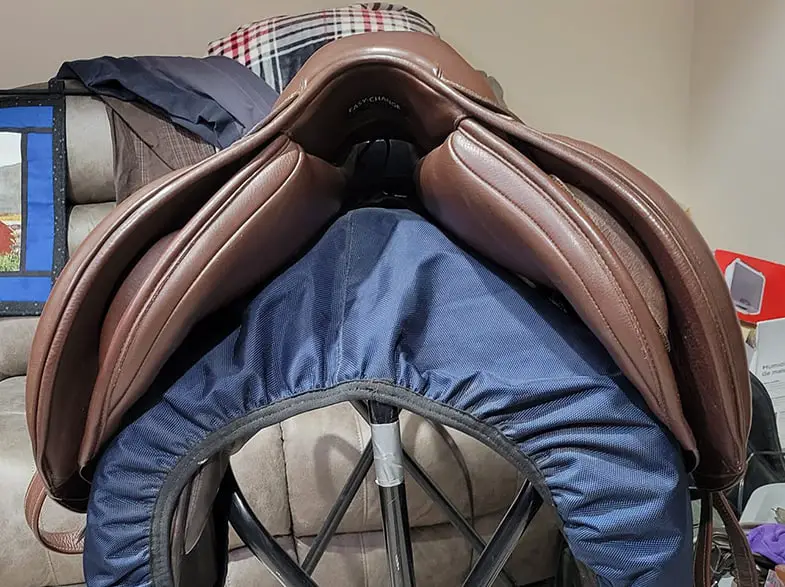You might think that you don’t need to know the different parts of a horseback riding saddle and that it doesn’t matter if you don’t know the difference between the saddle flap and the sweat flap but it’s actually a fundamental part of learning to ride. It’ll help you to understand how your actions affect the horse as well as help the two of you work together in harmony. On top of that, it’ll also enable you to know what adjustments you can (or need to) make for a more comfortable, safe, and enjoyable ride; for both you and the horse.
There are two main styles of horseback riding, English and Western, both of which have different saddles and while they do share some common parts there is also a number of unique parts to both saddles. In this article we’ll look at the various parts that make up an English saddle so read on to learn the names of these parts as well as what their purpose is.
Parts of an English riding saddle
The origins of an English riding saddle date back to a time when fox hunting was a popular pastime and riders needed a lightweight saddle that would be comfortable at speed. This meant that every part of the saddle had to have a purpose and anything that didn’t was removed.
Pommel
The pommel is the raised part at the front of the saddle. It’s where the tree and gullet (both underneath the saddle) come together and is raised higher than the rest of the saddle to give clearance to the horse’s withers. The height of it also gives security to the rider as it helps to ‘hold’ them in the saddle and can be used by new riders for support.
Twist
Sometimes referred to as the waist, the twist is the narrowest part of the saddle and is in between the pommel and the seat. The size of the twist (which can be narrow, medium to wide) will determine how the saddle sits between the rider’s legs. It can have a big impact on a rider’s comfort, especially female riders.
Seat
As you can tell by the name, the seat is the part of the saddle where the rider actually sits. The seat is the lowest part of the saddle’s topline and can range in depth from shallow to medium, medium deep, and deep. While the depth of the ‘dip’ in the seat will determine how secure the rider is (and feels) its depth can also be determined by the saddle’s intended purpose. For example, dressage saddles have a far deeper seat than jumping saddles.
Cantle
Like the pommel, the cantle is raised above the seat although this time it’s at the back of the saddle. It’s designed to give the rider support but the angle of it will help to determine the depth of the seat.
D-rings
Not present on every saddle, d-rings are rounded or square metal rings that are attached to the front of the saddle and can be used to attach accessories such as breastplates. Some saddles will also have d-rings at the back for a crupper, saddle bags, or other accessories.
D-rings can either be fixed to the arch of the tree or attached to the saddle with leather, the former gives extra strength while the latter allows for them the break away from the saddle when under stress.
Skirt
Also known as the jockey skirt (or even just the jockey), the skirt is a small flap of leather that covers the stirrup bar. The idea is that it prevents the rider’s leg from rubbing against or being pinched by the metal bar. It also has the added benefit of stopping the stirrup buckle from coming undone and sliding down.
Stirrup bar
A structural part of the saddle tree, the stirrup bar is a metal bar that sits under the skirt and allows the rider to quickly and easily remove or change the stirrups. It’s also designed to transfer the rider’s weight and pressure properly over the horse’s back.
The stirrup bar has a lever at the end that can be turned 90° upwards to lock the stirrups in place and prevent them from sliding off. That said though it’s generally considered safer to ride with the stirrup bar unlocked. This is because there’s less risk of the rider’s foot being stuck in the stirrups and therefore dragged along by a bolting horse. Leaving it unlocked will also help if you need to make a dismount in an emergency.
Want to learn more about getting off in an emergency? How to make an unplanned dismount.
Stirrup Leather Keeper
Sometimes referred to as a keeper, the stirrup leather keeper can either be a slit in the saddle or a strip of leather attached to the saddle. The purpose of it is to keep the excess of the stirrup leather out of the rider’s way.
Stirrup leather *
Despite the name, stirrup leathers aren’t always made of leather (they can also be synthetic) but traditionally they were so the name has now stuck. They’re the straps that go through the top of the stirrups and over the stirrup bar to connect the stirrups to the saddle. The stirrup leathers come in a variety of different lengths, depending on the length of the rider’s leg but are typically available in 48” (for children), 54” (for the ‘average’ rider), and 60” (for dressage).
With English saddles, they’re not normally sold with the saddle and will need to be bought separately.
Stirrup Iron *
Not only are the stirrup irons used to help the rider get in the saddle but also help to keep their leg in place while riding. As well as balancing the rider’s feet they’ll also disperse their weight over the horse’s back rather than putting pressure on any one part.
These days many stirrups are safety irons which means that if the rider falls the stirrup will come apart to prevent their foot from getting stuck in the stirrup. The safety mechanism can either be a rubber band that breaks or a hinged arm that comes apart easily.
Like stirrup leathers, the irons (which are normally made of stainless steel) are often sold separately from the saddle.
Knee roll
Not every saddle will have knee rolls but they’re designed to keep the rider’s knees from sliding too far forward and to add comfort and cushioning for the knee. If a saddle has them then they can be seen on the front of the saddle flap.
Sometimes called knee pads, they can be retrofitted if a saddle doesn’t have them.
Thigh roll
Far more common on dressage and general purpose saddles than on jumping saddles, the thigh roll is similar to the knee roll but can be found at the back of the saddle flap. As well as providing the rider with extra stability they also offer cushioned support for the thigh.
Saddle Flap
The saddle flap (or flap as it’s sometimes called) refers to the large piece of leather that’s underneath the rider’s leg and isn’t in direct contact with the horse. It’s designed to create a comfortable place for the rider’s leg to sit and protects them from the billets, girth, and billet guard. The style of the saddle flap will depend, to some extent, on the saddle’s intended use and the discipline it’s being used for. For example, dressage saddles have straight flaps while jumping saddles have a shorter, more covered saddle flap.
Billet Straps
Also known as girth straps, the billet straps are a crucial part of the saddle as it’s where the girth attaches to the saddle. Most saddles have three billet straps which means, that because girths have two buckles, there’s a spare strap in case one of the others break.
The billet straps are often an overlooked part of the saddle but should be checked regularly for wear and tear as well as for damage.
Billet guard
Once a girth has been attached to the saddle a billet guard (or billet keeper) is used to protect the underside of the flap from the girth buckles. It also helps to smooth the buckle out and make it more comfortable for the rider.
Some saddles have long billets which means there’s no need for a billet guard as the buckles aren’t underneath the saddle flap.
Girth *
While it’s not really part of the saddle (which is why it’s sold separately) the girth is still, nevertheless, vital to the saddle’s proper use as it’s the strap that goes underneath the horse, attaches to the billets, and holds the saddle in place. It’s important that it’s tight enough so that the saddle doesn’t move but not so tight that it’s uncomfortable (or even painful) for the horse.
Girths can be made from a range of materials but are normally soft and have a padded underside. They have one or two buckles on either side that fasten to the billet straps.
Knee block
Found under the saddle flap, the knee block is a removable and adjustable solid block that gives the rider’s leg extra support. It sits directly underneath the knee roll and can be adjusted to suit the rider.
Thigh block
Just like the knee block, the thigh block can be removed and adjusted to suit the rider’s needs and preferences. Its purpose is to give the leg more support and help the rider to keep their leg in place.
Sweat flap
The sweat flap is a large piece of leather (or synthetic material) that is on the underside of the saddle and sits between the horse and the billet straps. As its name suggests it protects the saddle from the horse’s sweat, although it also stops the horse from being pinched by the girth buckles.
Underneath the saddle
While it can be easy to forget about the parts of the saddle you don’t see, it’s just as important if not more so, to know the different parts underneath the saddle. Especially when you consider that many of these parts are integral to the saddle’s structure.
Tree
Taking its name from the fact that it used to be made of wood (and still is in some cases), the tree is the rigid part of the underside of the saddle that helps to give it shape. It also helps to distribute the rider’s weight evenly over the horse’s back and therefore alleviates pressure sores and pain in the horse.
While the tree is essential to the saddle’s rigidity it’s worth pointing out there not every saddle has one. Known as treeless, these saddles do have their advantages. Check out this article if you want to know more about the pros and cons of treeless saddles.
Gullet
Sometimes referred to as the head plate, the gullet is the arched area that’s directly underneath the pommel. It helps to keep the saddle off of the horse’s withers and prevents the saddle from pinching the horse’s neck.
Panel
The panel is the only part of the saddle that can be seen from both underneath it and when it’s the right way round. It’s the cushioned part that runs along the sides of the gullet and is designed to give support to the horse’s back. In the past, it was filled with wool but today the filling can be made from foam, air, latex, and of course wool.
Channel
Running along the underside center of the saddle, the channel allows the saddle to sit on either side of the horse’s spine. This means that no pressure is placed on the horse’s vertebrae at all which is why it’s probably the single most important part of the saddle when it comes to fitting.
* generally sold separately to the saddle
Not sure how to clean your saddle? Check out this guide on the best way to clean a leather saddle.
What tack does your horse need? Everything you need to ride.
I hope you found this article helpful. If you did I’d be grateful if you could share it please as it would really help me.
Recommended products
Over the years I have tried hundreds of different horsey products, from various blankets and halters to different treats. Some I’ve loved, others I’ve hated but I thought I’d share with you my top all-time favorite products, the ones I never leave the yard without. I’ve included links to the products (which are in no particular order) that I really think are great.
- Horse Knots by Reference Ready – If you’re like me and enjoy pocket reference guides then you’ll love this knot tying guide. These handy cards can easily fit in your pocket or attach to the saddle for quick reference. They’re waterproof, durable and are color coded to make them easy to follow.
- Mane ’n Tail Detangler – Even if you never show your horse you’ll need to detangle his tail from time to time (and possibly his mane too) which is always a challenging chore! I’ve found that if I run a little bit of detangler through my horse’s tails every few days it stops them from getting matted up and makes combing them easy, even if they’re coated in mud. I don’t know if I should admit to this or not but it also works wonders on my hair.
- TAKEKIT Pro clippers – Over the years I’ve tried a lot of different clippers and while some were obviously better than others I found these to be by far the best. They are heavier than a lot of other clippers but for me, that’s a good thing, it makes them feel more sturdy and hardwearing. On top of that they have a range of speeds so are just as good for clipping your horse’s back as they are his face. I also like the fact that they come in a handy carry case but that’s not for everybody. The company that makes them is super good and incredibly helpful too, a real bonus these days. The only thing I wasn’t keen on was the fact that it doesn’t come with any oil, but that’s not a major problem as it’s not difficult to buy lubricant.
- Shire’s ball feeder – There are so many boredom buster toys out there but I like to use these every day, regardless of whether or not my horses are bored. I find that it helps to encourage my horses to problem solve by rewarding them with treats (or pieces of fruit) but it also mimics their natural grazing behavior which helps to keep them calm and de-stressed.
- Horse safe mirror – This is a strange one that many people are surprised about but I like to put horse safe mirrors in the trailers as well as in the quarantine stalls. It helps to prevent the feeling of isolation by giving the impression of other horses being around. Being herd animals horses can get extremely stressed when they feel that they’re on their own but with these stick-on mirrors, they believe that at least one other horse is with them.
- Rectal thermometer – I know this isn’t glamourous at all but it’s vital for your horse’s well-being to be able to check their temperature and a rectal thermometer is the easiest way of doing this which is why I’ve added it to the list.
Shopping lists
I’ve also put together a few shopping lists of essential items that I’ve found helpful over the years. I’ve broken the lists down into different categories rather than put everything in one massive list 😉

